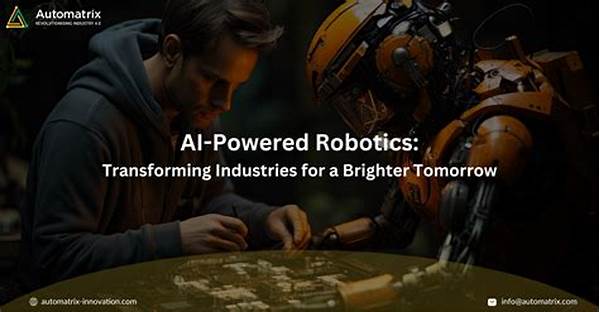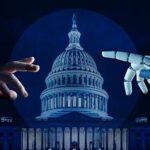In the modern era, where technology is rapidly evolving, one of the most compelling developments is the amalgamation of artificial intelligence and robotics. The fusion of these technologies promises not just incremental improvements in how tasks are carried out, but a radical shift in operations across various industries. Why AI-powered robotics are transforming industries is not just a headline for futuristic sci-fi stories; it’s a reality already taking shape in front of our eyes. From manufacturing and logistics to healthcare and customer service, AI-powered robotics are at the forefront of revolutionizing businesses in a manner that was once unimaginable.
Read More : How Ai Shapes The Future Of Smart Cities
Picture a world where repetitive tasks are handled with precision by a machine, leaving humans free to engage in more meaningful work. Imagine industrial robots performing complex surgeries with incredible accuracy, or AI systems managing the intricate logistics of supply chains faster and more effectively than any human ever could. These scenarios are no longer confined to the realms of imagination or Hollywood fantasies. They are tangible realities powered by the latest advancements in artificial intelligence and robotics technology, proving why AI-powered robotics are transforming industries worldwide.
Industries have constantly been under the hammer of transformation since the dawn of time. However, the current wave of AI-powered robotics is setting a new precedent. Unlike the transformations of the past driven by human muscle or rudimentary mechanical inventions, today’s revolution is smarter, faster, and more adaptive. It is driven by data and learning algorithms capable of processing information at speeds incomprehensible to the human mind. This is why AI-powered robotics are transforming industries, providing not just enhancements, but complete overhauls of traditional methodologies.
The global market for AI in robotics is projected to explosively grow over the next decade, evidenced by market analysis and industry forecasts. This growth is reflective of the increasing reliance on AI robotics solutions to solve complex problems and streamline processes. The drive to adopt such technologies is further fueled by the competitive edge it provides; those who adopt AI robotics can operate more efficiently, reduce errors, and offer more personalized services. It’s no wonder corporations are keen to understand how AI-powered robotics can be integrated into their strategic frameworks to leap ahead of the competition.
The Role of AI-Powered Robotics in Modern Industries
Understanding the transformative potential of AI-powered robotics requires more than just acknowledgment; it mandates a deep dive into specific use cases that showcase their versatility and efficacy. In the world of logistics, for instance, companies utilizing AI-powered robots for sorting and processing packages have seen incredible improvements in speed and accuracy, reducing delivery times while minimizing errors. Manufacturing plants equipped with AI-driven robots are experiencing leaps in efficiency, bringing down operational costs and enhancing product quality.
In healthcare, AI-powered robotic systems assist surgeons with precision tasks that are critical in complex procedures, thereby reducing surgical errors and improving patient outcomes. Beyond the surgical room, AI is used for diagnostic purposes, where algorithms help doctors in diagnosing diseases more accurately and at an earlier stage. Financial services leverage AI robotics to conduct high-frequency trading and fraud detection, showcasing the breadth of why AI-powered robotics are transforming industries across sectors.
—
In today’s world, where technological advancements are being made at an exponential rate, the combination of artificial intelligence and robotics stands at the crux of innovation. AI-powered robotics is not merely a catchphrase used in speculative fiction or Silicon Valley pitches; rather, it represents a tangible revolution across various industrial landscapes. Why AI-powered robotics are transforming industries has become more than just a question; it is a testament to the incredible potential of blending cognitive computing with mechanical automation.
Historically, the progression from simple manual labor to more sophisticated machinery marked waves of industrial revolutions, each bringing profound changes to the way industries operated. However, we are now witnessing a different kind of transformation, spearheaded by smart machines capable of learning and adapting. AI-powered robots are not confined to the rigidity of pre-programmed tasks. They self-learn, analyze vast datasets, predict outcomes, and most importantly, evolve with time, making them indispensable assets to industries wanting to gain an edge in an ever-competitive market.
The Mechanisms Driving Transformation
To fully grasp why AI-powered robotics are transforming industries, one needs to explore the core mechanisms that drive their impressive capabilities. Machine learning algorithms allow robots to process and interpret complex datasets much faster than any human could. This capability translates into actions where robots can make real-time decisions, improving efficiency and reducing the margin for error. In industries such as automobile manufacturing, this means producing better vehicles in shorter cycles, while in healthcare, it translates to more accurate diagnostics and treatment plans.
Industry-Specific Applications
The applications of AI-powered robotics extend far and wide, touching numerous facets of industrial operations. In the agricultural sector, smart robots are enhancing yield predictions and ensuring quality control by monitoring crops in real time. Meanwhile, in retail, AI-powered robots are revolutionizing inventory management and customer interactions, enabling a more personalized shopping experience. AI’s ability to assess and act upon customer data means that businesses can offer services tailored to individual preferences, showcasing yet another angle of why AI-powered robotics are transforming industries.
As businesses continue to explore the vast potential AI-powered robotics hold, it becomes evident that these technologies are not merely optional upgrades but essential components for staying ahead. Organizations that choose to integrate these systems into their core operations often see significant improvements not just in productivity but in strategic capability — the ability to predict market changes, understand consumer demands, and respond quicker than ever before. Given these transformative advantages, it’s no wonder industries are racing to adopt these intelligent systems.
—
Short Introduction to AI-Powered Robotics in Industries
The age of artificial intelligence and robotics is not approaching; it’s already here, redefining the landscape across multiple industries. Companies around the world are embracing innovative AI tools that promise to reshape the traditional paradigms of work, offering enhanced efficiency and breakthroughs that were only dreams a few decades ago. Why AI-powered robotics are transforming industries is rooted in their ability to perform tasks beyond human capability while learning and optimizing themselves continuously.
Industries from healthcare to logistics are not just dipping their toes into this technological marvel but are diving headfirst, integrating AI at every level of operation. In just a few short years, AI-powered robotics have moved from buzzword status to critical components of success for modern enterprises. The implications are far-reaching, with the potential to solve problems at scales previously considered insurmountable, offering a glimpse of a future where AI and robotics coexist harmoniously within industry confines.
This transformation is not just technological; it’s strategic. Companies realize that to stay relevant in an increasingly competitive market, embracing AI-powered robotics is non-negotiable. The potential for smarter supply chains, predictive consumer insights, and autonomous operations creates a robust argument for adoption. As these powerful technologies continue to advance, industries are poised not just to keep pace, but to set the pace of innovation for the world.
—
It’s no secret that AI-powered robotics represent a cornerstone in the evolution of industrial landscapes worldwide. These technologies are reshaping everything from production line outputs to service-based interactions. To truly understand why AI-powered robotics are transforming industries, we must examine the profound impacts these technologies have on specific sectors.
At the heart of the Fourth Industrial Revolution, manufacturing has seen significant enhancements through the adoption of AI-powered robotics. Production lines now feature smart robots capable of executing complex tasks with precision and efficiency, resulting in faster turnarounds and higher quality products. This marks a paradigm shift from traditional assembly lines to smart, flexible manufacturing centers that can adapt to changes quickly — a necessity in today’s fast-paced market.
In logistics, AI-driven robots are transforming the way goods are sorted, packed, and shipped. Companies employing these advanced systems can meet consumer demands faster and with lower error rates — a competitive edge in e-commerce, where speed and accuracy are paramount. The implications here are vast, suggesting a future where supply chains are not just automated but intelligent networks capable of learning and evolving without human intervention.
Moreover, the healthcare industry stands to gain significantly from AI-powered robotics, particularly in surgical and diagnostic areas. Surgical robots enhance precision and control, reducing the risk during intricate procedures. AI systems help with diagnostics by analyzing vast amounts of medical data to identify diseases earlier and more accurately. This advancement is not merely about making healthcare more efficient but about saving lives, proving why AI-powered robotics are transforming industries related to human welfare.
Why These Transformations Matter
These transformations are not just technological upgrades but revolutions that alter the fabric of industrial processes. The role of AI in robotics inspires industries to rethink their strategies, placing data and machine intelligence at the core of their operations, bringing about efficiency, quality, and innovation like never before.
Future Outlook and Challenges
The journey with AI-powered robotics is just beginning. As we move forward, several challenges, including ethical concerns and the need for regulatory frameworks, will come to the forefront. However, with these challenges come opportunities for those adept at navigating the intricate dance of innovation and regulation. Industries that can effectively manage these dynamics are poised to lead the global market, showcasing again how and why AI-powered robotics are transforming industries on every level.
In conclusion, the convergence of AI and robotics is not just shaping the future; it’s crafting the present. The industries that harness this power today are setting the stepping stones for a future where human potential is amplified, not replaced, by intelligent machines. As this evolution continues, it remains crucial for stakeholders to grasp not just the how, but the why — the why that will define the next wave of industrial transformation.


